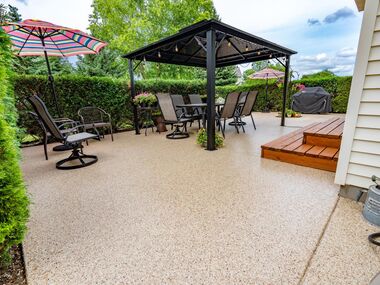Planning Your Home's Painting Schedule for the New Year

Residential painting is a great home improvement project to tackle next year, especially if it has been a few years since you had your house painted. A new coat of paint will make your living environment feel brand new and even boost its overall value. If you’re ready to plan your home’s painting schedule for the next year, below are some expert tips to help you out.
How Many Times a Year Should You Paint Your House?
If you are on the fence about repainting your home, think about the last time you've done it. Experts recommend repainting your house every 3-5 years (depending on the paint’s quality, wear and tear, and personal preferences). But it won’t hurt to have it done any time you like. You don't have to wait three years or more if you plan to sell your home soon, notice fading and peeling paint, or just want to update your space’s aesthetics.
Importance of Planning Your Painting Schedule
If you decide it’s time for a fresh coat of paint, planning your painting schedule is crucial, especially during the busy season. Scheduling ahead of time helps you avoid the rush and allows you to find money-saving deals. You’ll also be able to choose a convenient schedule since the contractor's calendar won’t be full yet.
Planning Your Home's Painting Schedule: Tips and Tricks
There are a few tips to keep in mind when deciding the best time to paint your home.
Determine Which Rooms to Paint First
Painting a home, especially one with multiple rooms, is a big project. Aside from applying paint on walls, you’ll need to move or cover furniture, protect the floor, prepare surfaces, gear up, etc. All these steps entail a lot of energy and time, so making a game plan before you start is best. Part of this plan should be determining which rooms to paint first.
Here are some considerations when you’re prioritizing rooms for painting:
Amount of stuff: The more things you have in a room, the longer it will take to move them. Removing and then setting furniture, shelves, and other things back in a room increases the chances of damaging newly painted walls. For this reason, you should prioritize rooms with the most items in them.
Traffic: Save high-traffic areas, such as staircases and hallways, for last.
Impact on your day-to-day living: Prioritize commonly used spaces in your home, like your bedroom and bathroom.
Choose a Style and Color Scheme That Will Match the Existing Décor
One of the crucial parts of repainting a home is choosing a color scheme and style. Unlike painting a newly built house, your home has existing furnishing and décor. You will need to consider these when choosing a style and color scheme. The process may be overwhelming and confusing, but it will help ensure you get the best results from your painting project.
Consider picking a paint style and color scheme before you make a paint schedule. If you don’t know where to start, take a look around your place. List everything inside each space, including the carpet, wallpaper, and furniture. Start one room at a time. Assess the space for positive and negative traits, write down your findings, and determine focal points.
In addition, pay attention to lighting because it will affect the appearance of the paint. Learning about the impact of lighting will help you decide which colors to pick.
Determine What Type of Paint Works Best for Each Room in Your Home
Paints come in many types and finishes, not just colors. They can be water-based or oil-based. The former is less glossy and can maintain a lower sheen level over a long time. You can also opt for flatter or glossier paint regardless of composition.
Examples of water-based paints are latex and acrylic paints. They dry fast, retain color over time, and produce a milder odor, making them a great option for exterior painting. Water-based paints are also ideal for interior spaces with a lot of moisture, such as kitchens and laundry rooms.
On the other hand, oil-based paints can withstand routine contact and last for a long time, so they are ideal for trims and moldings. But on the downside, this type of paint takes more time to dry and has a stronger odor. Examples of this are alkyd and enamel paint.
Estimate How Much Paint You'll Need for Each Space and Determine Necessary Supplies
Determining how much paint your house will need is important, especially for a DIY painting project. The rule of thumb is to use one gallon for every three to four hundred square feet. However, the amount usually differs for some paint formulas and wall textures.
This part of planning involves some numbers. You must measure the length of the walls, multiply that by the height of the wall, and divide the total number by the estimated coverage of one gallon of paint. Fortunately, online calculators are available to do the calculation, so those who struggle with math can get the help they need.
If you’re entrusting your painting project to professional residential painters, there’s no need to worry about these calculations. The experts will take care of it. They know exactly how much paint your space will need.
Research Local Painting Contractors or Consider DIY Painting if You’re Confident Enough
If you want to hire a professional, part of your plans should include the search for a local painting contractor. Although you can easily find a painting contractor with just a few clicks on Google, it’s wise to allocate some time and effort in selecting who to hire. Besides, not all residential painting contractors are the same.
Consider variables like a contractor’s license, experience, and reputation. Don’t forget to read reviews, both positive and negative, and get references. You can assess the contractor better by conducting an initial interview. Ask questions, like what type and brand of paint they use, their pricing structure and certifications, etc.
But if you think you have the necessary skills and knowledge, you can go the route of DIY residential painting. With this option, you will have to bring out your toolbox and find out whether you have the tools and equipment for the job.
Factor in Necessary Repairs Before Applying Paint
Proper surface preparation is one of the keys to achieving a smooth, professional-looking, long-lasting paint finish. Part of surface preparation is fixing any damage to the wall. Whether it’s a minor crack or a big hole, you must repair it before applying the paint.
Avoid using band-aid solutions. Instead, discover and address the root cause of the damage. For example, a big and long crack in the wall may indicate tree roots venturing underneath your home. In this case, removing or managing the tree will be necessary to prevent the walls from cracking again.
Set a Timeline and Budget for Your Project
Last but not least, set a timeline and budget for your painting project. When setting a timeline, consider factors that affect the paint job, such as the necessary surface preparation and the property's structure.
When setting a budget, consider the project scope, the brand and amount of paint, and the necessary tools. If you're hiring a professional, get quotes from at least three companies and compare them to find the right fit.
Anderson Painting at Your Service
At Anderson Painting, we offer interior and exterior residential painting services in Raleigh, NC, Wilmington, and the Greater Triangle Area. Homeowners who want to update their property this New Year with a fresh coat of new paint can count on our team. With our team's expertise and skill, you'll get the house of your dreams. We handle home painting projects any time of the year (except exterior painting when it’s too hot, wet, or cold outdoors).
We offer free estimates if you're ready to start a home improvement project this New Year. So please feel free to get in touch to discuss your desired home improvement projects.



